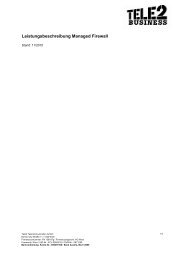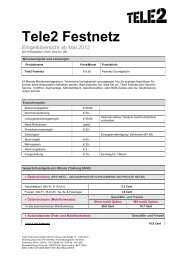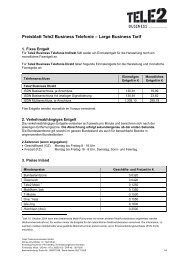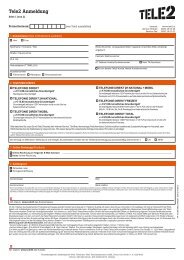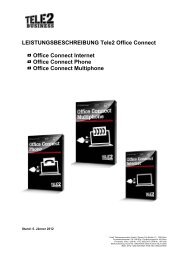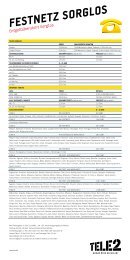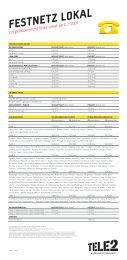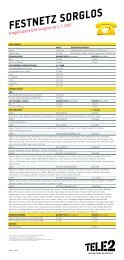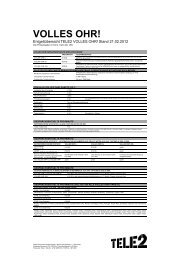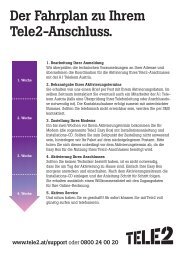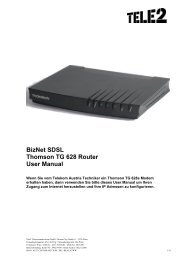Description of Services Tele2 Office Phone IP (Status: 09/2011)
Description of Services Tele2 Office Phone IP (Status: 09/2011)
Description of Services Tele2 Office Phone IP (Status: 09/2011)
Create successful ePaper yourself
Turn your PDF publications into a flip-book with our unique Google optimized e-Paper software.
additional extension numbers. Digits dialed after this time are ignored. Digits dialed after a call has been<br />
set up, are sent as DTFM (Dual Tone Multi Frequency) Information analogously to the PSTN.<br />
13.3. RFCs to <strong>Office</strong> <strong>Phone</strong> <strong>IP</strong><br />
The definitions in the RFCs below are minimum requirements for S<strong>IP</strong> end devices (S<strong>IP</strong> UA, S<strong>IP</strong> User<br />
Agents), that may be operated on <strong>Office</strong> <strong>Phone</strong> <strong>IP</strong>. If these are not met, the use <strong>of</strong> the end devices on<br />
<strong>Office</strong> <strong>Phone</strong> <strong>IP</strong> is prohibited.<br />
• RFC3261: S<strong>IP</strong>: Session Initiation Protocol. J. Rosenberg, H. Schulzrinne, G. Camarillo, A. Johnston, J.<br />
Peterson, R. Sparks, M. Handley, E. Schooler. June 2002. (Updated by RFC3265)<br />
• RFC3262: Reliability <strong>of</strong> Provisional Responses in Session Initiation Protocol (S<strong>IP</strong>). J. Rosenberg, H.<br />
Schulzrinne. June 2002. (Obsoletes RFC2543)<br />
• RFC3263: Session Initiation Protocol (S<strong>IP</strong>): Locating S<strong>IP</strong> Servers. J. Rosenberg, H. Schulzrinne. June<br />
2002. (Obsoletes RFC2543)<br />
• RFC3264: An Offer/Answer Model with Session <strong>Description</strong> Protocol (SDP). J. Rosenberg, H.<br />
Schulzrinne. June 2002. (Obsoletes RFC2543)<br />
• RFC3265: Session Initiation Protocol (S<strong>IP</strong>)-Specific Event Notification. A. B. Roach. June 2002.<br />
(Obsoletes RFC2543) (Updates RFC3261)<br />
• RFC3267: Real-Time Transport Protocol (RTP) Payload Format and File Storage Format for the<br />
Adaptive Multi-Rate (AMR) and Adaptive Multi-Rate Wideband (AMR-WB) Audio Codecs. J. Sjoberg, M.<br />
Westerlund, A. Lakaniemi, Q. Xie. June 2002.<br />
• RFC3581: An Extension to the Session Initiation Protocol (S<strong>IP</strong>) for Symmetric Response Routing. J.<br />
Rosenberg, H. Schulzrinne, August 2003.<br />
• RFC3891: The Session Initiation Protocol (S<strong>IP</strong>) "Replaces" Header. R. Mahy, B. Biggs, R. Dean.<br />
September 2004.<br />
• RFC3892: The Session Initiation Protocol (S<strong>IP</strong>) Referred-By Mechanism. R. Sparks. September 2004.<br />
Moreover, RFC drafts that define switchboard functions are also used. As these have not been definitively<br />
established, changes in accordance with the standards will be made over time at a later date. The drafts<br />
are being dealt with in the S<strong>IP</strong>, S<strong>IP</strong>PING and Network work groups, and can be found at:<br />
• http://www.ietf.org/ID.html<br />
• http://www.ietf.org/ids.by.wg/sip.html<br />
• http://www.ietf.org/ids.by.wg/sipping.html<br />
In particular, reference is made to the following drafts:<br />
• Session Initiation Protocol Call Control - Transfer. R. Sparks, A. Johnston Internet-Draft, Expires:<br />
August 15, 2004 draft-ietf-sipping-cc-transfer-02.txt<br />
• A Framework for Conferencing with the Session Initiation Protocol. J. Rosenberg Internet-Draft,<br />
Expires: December 28, 2004 draft-ietf-sipping-conferencing-framework-02.txt<br />
• Session Initiation Protocol Call Control - Conferencing for User Agents. A. Johnston, O. Levin Internet-<br />
Draft, Expires: August 15, 2004 draft-ietf-sipping-cc-conferencing-03´.txt<br />
• Session Initiation Protocol Service Examples. A. Johnston, R. Sparks, C. Cunningham, S. Donovan, K.<br />
Summers Expires: January 14, 2005 draft-ietf-sipping-service-examples-07.txt<br />
13.4. NAT and Firewalls<br />
In principle private <strong>IP</strong> addresses are supported in the customer LAN and in firewall-protected Internet<br />
accesses. The NAT (Network Address Translation) devices and firewalls must support the following<br />
connections from the private network to the Internet or external network.<br />
Outgoing connections for the protocols:<br />
DNS (UDP:53), NTP (UDP:123), HTTP (without proxy) (TCP:80), TFTP (UDP:69), RTP (> UDP:10000),<br />
SNMP (UDP:161 and UDP:162), S<strong>IP</strong> (UDP:5082)<br />
All source ports <strong>of</strong> these protocols must be translated to > 1024 at NAT.<br />
The connections must accept reply packets to outgoing requests after a time-out <strong>of</strong> up to 40 seconds<br />
(UDP time-out 40s).<br />
9<br />
<strong>Tele2</strong> Telecommunication GmbH / Donau-City-Straße 11 / 1220 Wien<br />
Firmenbuchnummer: FN 138197g / Firmenbuchgericht: HG Wien<br />
Firmensitz: Wien / UID-Nr.: ATU 39553103 / DVR-Nr.: 0871290<br />
Bankverbindung: Konto-Nr.: 696279108 / Bank Austria / BLZ 12000<br />
IBAN: AT52 1200 0006 9627 9108 / BIC: BKAUATWW



